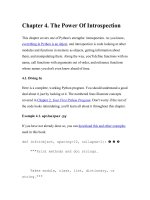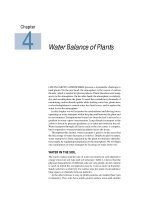normalization of database tables chapter 4
Bạn đang xem bản rút gọn của tài liệu. Xem và tải ngay bản đầy đủ của tài liệu tại đây (980.72 KB, 39 trang )
Chapter 4
Normalization of
Database Tables
Database Tables and
Normalization
Table is basic building block in database design
Table’s structure is of great interest
Two cases:
possible poor table structures in good database
design
Modify existing database with existing poor table
structure
Normalization can help recognize a poor table
and convert to good tables with good structure
2
Database Tables and
Normalization
Normalization is process for
assigning attributes to entities
Reduces data redundancies
Expending entities
Helps eliminate data anomalies
Produces controlled redundancies to link
tables
Cost more processing efforts
Series steps called normal forms
3
Database Tables and
Normalization
Normalization stages
1NF - First normal form
2NF - Second normal form
3NF - Third normal form
4NF - Fourth normal form
Better in
dependency
Business
Bioinformatics
Statistical data
Worse in
performa
nce (I/O)
4
Database Tables and
Normalization
Example: construction company
Building projects
Project number
Project name
Employees assigned
…
Employee
Employee number
Employee name
Job classification
5
Table 4.1 should be here.
6
Figure 4.1 Observations
PRO_NUM intended to be primary
key, but it contains null values.
Table entries invite data
inconsistencies
7
Figure 4.1 Observations
Table displays data redundancies
which yield the following anomalies
Update
Modifying JOB_CLASS
Insertion
New employee must be assigned project
(phantom project)
Deletion
If employee deleted, other vital data lost
8
Figure 4.2 is insert here.
Repeating group (any project can have
a group of data entries) which should
not to be appeared in relational table
9
Data Organization: 1NF
PK
PK
Figure 4.3
10
Conversion to 1NF
Repeating groups must be
eliminated
Proper primary key developed
Uniquely identifies attribute values
(rows)
Combination of PROJ_NUM and EMP_NUM
11
Conversion to 1NF
Repeating groups must be eliminated
Dependencies can be identified
A particular relationship between two attributes.
For a given relation, attribute B is functionally
dependent on attribute A if, for every valid value
of A, that value of A uniquely determines the
value of B.
A functional dependency exists when the value
of one thing is fully determined by another. For
example, given the relation EMP(empNo,
empName, sal), attribute empName is
functionally dependant on attribute empNo. If we
know empNo, we also know the empName.
12
Desirable dependencies based on
primary key
Less desirable dependencies
Partial
based on part of composite
primary key
on
Transitive
one nonprime attribute depends
13
Dependency Diagram
(1NF)
Above: Desired Dependencies
Figure 4.4
Composite primary key
Below: Less Desired Dependencies
14
PROJ_NUM,EMP_NUM PROJ_NAME, EMP_NAME,
JOB_CLASS,CHG_HOUR, HOURS
DESIRED DEPENDENCIES
PROJ_NUM PROJ_NAME
PARTIAL DEPENDENCIES
EMP_NUM EMP_NAME, JOB_CLASS, CHG_HOUR
JOB_CLASS -> CHG_HOUR
TRANSITIVE DEPENDENCIES
15
1NF Summarized
All key attributes defined
No repeating groups in table
All attributes dependent on
primary key
16
Conversion to 2NF
Start with 1NF format:
Write each key component on
separate line
Write original key on last line
Each component is new table
Write dependent attributes after
PROJECT (PROJ_NUM, PROJ_NAME)
each(EMP_NUM,
key EMP_NAME, JOB_CLASS, CHG_HOUR)
EMPLOYEE
ASSIGN (PROJ_NUM, EMP_NUM, HOURS)
17
2NF Conversion Results
Figure 4.5
18
2NF Summarized
In 1NF
Includes no partial dependencies
No attribute dependent on a portion of
primary key
Still possible to exhibit transitive
dependency
Attributes may be functionally dependent
on nonkey attributes
19
Conversion to 3NF
Create separate table(s) to eliminate
transitive functional dependencies
PROJECT (PROJ_NUM, PROJ_NAME)
ASSIGN (PROJ_NUM, EMP_NUM, HOURS)
EMPLOYEE (EMP_NUM, EMP_NAME, JOB_CLASS)
JOB (JOB_CLASS, CHG_HOUR)
20
3NF Summarized
In 2NF
Contains no transitive
dependencies
21
Additional DB
Enhancements
Figure 4.6
22
23
Boyce-Codd Normal
Form (BCNF)
Every determinant in the table is a
candidate key
Determinant is attribute whose value
determines other values in row
3NF table with one candidate key is already
in BCNF
24
3NF Table Not in BCNF
Figure 4.7
25









